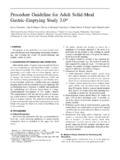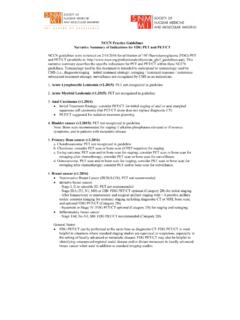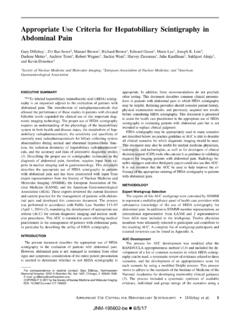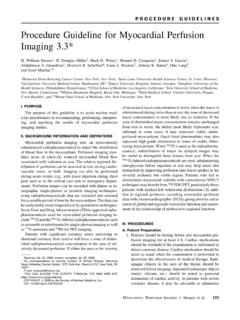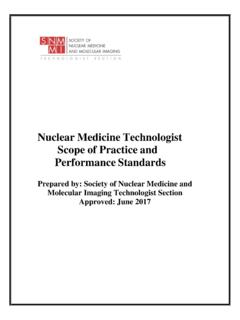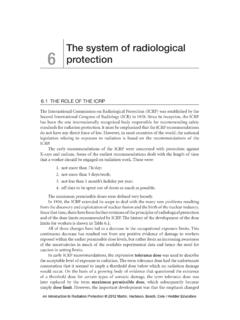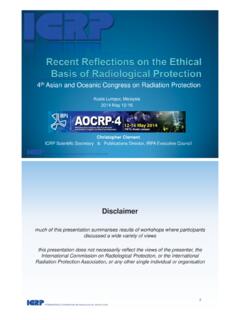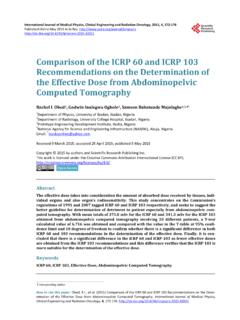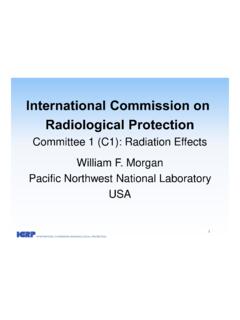Transcription of Society of Nuclear Medicine P r ocedure Guideline for ...
1 Purpose of this Guideline is to assist nuclearmedicine practitioners in recommending, perform-ing, interpreting, and reporting hepatic and splenicimaging Background Information and spleen imaging is performed after the in-jection of a 9 9 mTc-labeled colloid that has beenrapidly phagocytized by the reticuloendothelialcells of the liver, spleen, and bone .Liver blood pool imaging is performed after theinjection of 9 9 mTc-labeled red blood cells for thedetection of cavernous hemangiomas of the hepatic perfusion studies are performed afterthe injection of 99mTc-macroaggregated albumin(MAA)
2 Through a hepatic artery catheter to de-termine that intra-arterially administered agentsare delivered imaging is performed after the injectionof 9 9 mTc-labeled heat-damaged red blood red blood cells are taken up selectivelyby functioning splenic Common IndicationsA. Liver Spleen ImagingThis study can be used for determining the sizeand shape of the liver and spleen as well as fordetecting functional abnormalities of the reticu-loendothelial cells of these organs. Specifically,these studies are occasionally performed:1.
3 For suspected focal nodular hyperplasia ofthe liver. These lesions often have normal orincreased uptake on sulfur colloid .To assess the function of the reticuloendothe-lial system in patients with suspected liver dis-ease. The decision to perform a liver biopsy orto continue treatment with a hepatotoxic agentmay be influenced by the severity of liver dis-ease that is seen on liver spleen Liver Blood Pool ImagingThis test is highly specific for cavernous heman-giomas of the liver.
4 The sensitivity for detectinglesions of the liver (>2 3 cm) is also high. He-mangiomas as small as cm may be detectedwith single-positron emission computed tomog-raphy (SPECT) using a multihead hepatic Perfusion ImagingThis study is useful for demonstrating that hep-atic artery catheters used to infuse chemothera-peutic or therapeutic radiolabeled microsphereagents are positioned optimally to perfuse livertumors and to avoid perfusion of normal extra- hepatic tissues ( , stomach).
5 D. splenic ImagingThis study is used for detecting functionalsplenic tissue. This study is often children to rule out congenital asplenia adults whose thrombocytopenia has beentreated previously with characterizing an incidentally noted massas functional splenic tissueIV. ProcedureA. Patient PreparationNo patient preparation is .Information Pertinent to Performing the Procedure1. Relevant history and results of physical results of other anatomic imaging studies3. The results of liver function splenic imaging , the results of a completeblood count and platelet hepatic perfusion studies, the position ofthe hepatic artery catheterSociety of Nuclear Medicine P rocedure Guideline for hepatic and splenic imaging , approved July 20, 2003 Authors:Henry D.
6 Royal, MD (Mallinckrodt Institute of Radiology, St. Louis, MO); Manuel L. Brown, MD (Henry FordHospital, Detroit, MI); David E. Drum, MD (West Roxbury Veterans Administration, Boston, MA); Conrad E. Nagle, MD(William Beaumont Hospital, Troy, MI); James M. Sylvester, MD (Our Lady of the Lake Medical Center, Baton Rouge,LA); and Harvey A. Ziessman, MD (Georgetown University Hospital, Washington, DC).C. PrecautionsWhen red blood cells are labeled, strict adher-ence to a procedure designed to prevent the ad-ministration of one patient s labeled red bloodcells into another patient is mandatory.
7 Proce-dures and quality assurance for correct identifi-cation of patients and handling blood productsare essential. See the Society of Nuclear MedicineProcedure Guideline for Use of Radiopharmaceutical1. Liver spleen imaging9 9 mTc-sulfur colloid (SC) is preferred forliver spleen imaging because the biodistribu-tion and biokinetics of this agent are more re-producible than those of 9 9 mTc-albumin col-loid (AC). At the time of this revision,9 9 mTc-AC was no longer available in theUnited Liver blood pool imaging9 9 mTc-labeled red blood cells can be labeledusing in vitro, in vitro/in vivo, or in vivomethods.
8 Methods with higher labeling effi-ciency (in vitro/in vivo or in vitro) may im-prove the results of imaging . Some expertsrecommend using only in vitro hepatic artery perfusion imaging 99mTc-MAA is injected slowly via the hepaticarterial catheter or infusion splenic imaging 9 9 mTc-labeled red blood cells typically aredamaged by heating for 20 min in a waterbathat 49 50 Image Acquisition1. Liver spleen imagingImaging is begun 10 15 min or longer afterthe intravenous administration of 9 9 mT c - c o l-loid.
9 Anterior, posterior, right lateral, rightanterior oblique, and right posterior obliqueimages of the liver are commonly posterior oblique and left lateral viewsare added for evaluating the spleen. Forsmall-field-of-view gamma cameras andstandard amounts of administered activity,images are usually collected for a minimumof 300,000 500,000 counts. For large-field-of-view gamma cameras, an anterior image is54 hepatic AND splenic IMAGINGR adiation Dosimetry in Normal Adults99mTc-colloid*150 220 Spleen (4 6) ( )( )99mTc-labeled red 750 cells (20 25) ( )( )9 9 mTc-macroaggregated 40 110 LiverVariablealbumin(1 3)Variable(Variable)(Variable)99mTc heat-damaged40 blood cells (1 3) ( )( )RadiopharmaceuticalEffective DosemSv /MBq (rem/mCi)Organ Receiving theLargest Radiation Dose mGy/MBq(rad /mCi)AdministeredActivityMBq(mCi)
10 * international commission on radiological Protection. Radiation Dose to Patients from report 53. London, UK: ICRP; 1988:180. international commission on radiological Protection. Radiation Dose to Patients from report 53. London, UK: ICRP; 1988:210. international commission on radiological Protection. Radiation Dose to Patients from report 53. London, UK: ICRP; 1988:212. usually acquired for 500,000 1 millioncounts. Subsequent images are then obtainedfor the same length of time as the anterior im-age.

